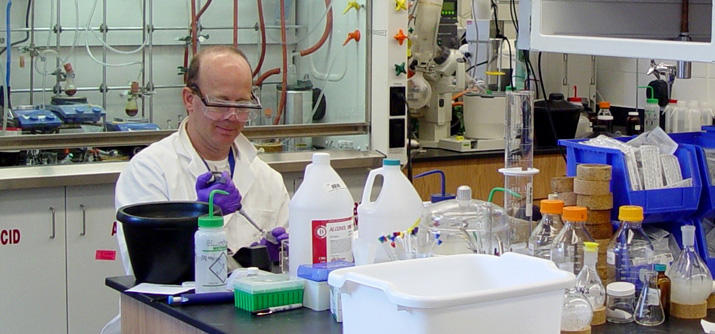Emory Scientists Developing Drugs To Treat Zika Virus

Emory University senior development scientist Dr. Michael Hager is a member of the chemistry staff at EIDD, one of the two drug development teams at Emory working to find a treatment for those infected by the Zika virus.
EMORY INSTITUTE FOR DRUG DEVELOPMENT
More than 20 scientists with two drug development groups at Emory University are working to develop a treatment for the Zika virus.
Dr. Abel De La Rosa said while federal health agencies like the National Institutes for Health work on developing a vaccine, it’s important for other scientists to be working on a drug to treat people who’ve already been infected. De La Rosa is the chief scientific officer of both the Emory Institute for Drug Development (EIDD) and Drug Innovation Ventures at Emory (DRIVE).
“Anytime there’s an emerging disease like Zika or Chikungunya, it’s always smart to work in parallel,” De La Rosa said. “It might be that you come up with a vaccine and that’s fantastic, we can vaccinate everybody. But if we don’t, we also have a drug.”
More than 500 scientists at the Atlanta-based Centers for Disease Control and Prevention are now studying the virus and working on an emergency response.
Testing Drugs
De La Rosa said his team has been working on treatments for viruses like Dengue and Hepatitis C, which are in the same family as the Zika virus, for the past three years.
“We’ve got all these drugs that we’ve synthesized and what we’re trying to do right now is accelerate the program by making a test or an assay to test these drugs against the specific enzyme of the virus that makes the virus replicate called the RNA Polymerase,” De La Rosa said. “Once we have that up and running, we’ll quickly be able to test the drugs that we have to see if they work against the Zika virus.”
De la Rosa said he thinks it’s only a matter of time before his group finds a drug to treat the infection caused by the Zika virus.
“Our entire focus has been on these types of drugs against RNA viruses,” De La Rosa said. “Zika is an RNA virus. That’s all we do. Nucleosides and nucleotides against RNA viruses.”
Typically, getting a vital drug to market can take around seven years, but if global health officials deem it necessary, clinical studies of the drug on humans could be fast-tracked and begin in two to three years.
The Drug Gap
DRIVE and EIDD Chief Operating Officer David Perryman said the groups that he leads at Emory were created to fill the gap left by pharmaceutical companies in global health emergencies.
“We’re kind of on that leading edge of taking university traditional discoveries that don’t get developed because they’re not commercial enough, but they’re of huge importance so that we don’t get as sick or die, and that’s what EIDD and DRIVE do, they fill that gap,” Perryman said.
Perryman said vaccines are always needed for infectious diseases, but drugs can help fill the gap.
“The scientists that we have are some of the rockstars for this particular type of chemistry that’s been the most successful for antivirals,” Perryman said. “Other places might be taking vaccine approaches and those have not universally been successful, so you need drugs to go along with those.”
9(MDAxODM0MDY4MDEyMTY4NDA3MzI3YjkzMw004))






